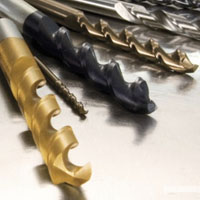 Probably almost every self-respecting man in his home kit has such a useful and important tool as an electric drill . With its help, you can perform a very large number of various important works related to the fastening of various parts using bolts and self-tapping screws, as well as creating various holes.
Probably almost every self-respecting man in his home kit has such a useful and important tool as an electric drill . With its help, you can perform a very large number of various important works related to the fastening of various parts using bolts and self-tapping screws, as well as creating various holes.
For specific work, a separate type of drill is also required. It is about the types of drills, their design, purpose and features that we want to talk about in this article.
Drills can be classified by purpose and by type of material and by shape, but in the article we will give a classification according to the design and material for drilling which these drills are used for. So we think it will be more convenient for readers.
Fountain drills
These drills that fit the classic segmental chuck got their name because of their shape - flat in the form of a feather. They are intended for drilling rather soft materials: wood or artificial materials based on it, such as MDF, chipboard, etc.
Typically, these drills are sold in stores in sets, but you can also find individual drills.
The diameter of such drills starts from 10 mm and ends with sufficiently large diameters - up to 30 mm. Due to its design, the drill does not cut off the material, but rather scrapes off, therefore it is impossible to drill hard material with them - just roll the cutting edges and that's it.
Typically, these drills are used when drilling fairly thick wooden blanks (from 10 mm or more): doors for locks, holes for pipes and wiring, carpentry parts, etc. If you start drilling thin plywood or fiberboard, the hole may turn out quite uneven, especially at the exit.
 Fostner drills
Fostner drills
Fostner drills are quite massive drills for soft materials: plastic, wood, plywood, fiberboard, etc. At the same time, a feature of using these types of drills is usually that they are mostly used for drilling blind even holes.
They are most widely used to create holes for the hinges of cabinets or other furniture. The advantage of using such drills is that due to the direction of the cutting edges, the hole is very even, even in laminated chipboard.
The downside is that there is a protrusion in the center of the drill, which primarily serves to center the drill (so that it does not move to the side), and if you drill relatively thin material, this protrusion can pierce the material through without deepening the main hole to the desired depth .
Classic twist drills
This class of drills for an electric drill is the most common. All of them have been seen more than once, and many only know about them and know that these are drills.
In appearance, these drills are a cylindrical metal cylinder, the length of which is many times greater than the diameter, on which there is partially a spiral cutting of great depth. The material used for the production of drills are durable metal alloys with a high carbon content.
The cutting edge is sharply sharpened at a certain angle, depending on what material the drill is intended for drilling.
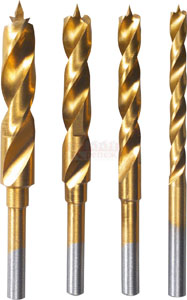 All drills of this class can be divided into two parts. In simple terms, they are divided into drills for wood and drills for metal. Drills for wood (and here we also mean materials comparable to it in density) have a special protrusion in the center that prevents the drill from going to the side during penetration into the material and drills for metal, which are much stronger and are used for drilling steel, aluminum, copper , various alloys, etc..
All drills of this class can be divided into two parts. In simple terms, they are divided into drills for wood and drills for metal. Drills for wood (and here we also mean materials comparable to it in density) have a special protrusion in the center that prevents the drill from going to the side during penetration into the material and drills for metal, which are much stronger and are used for drilling steel, aluminum, copper , various alloys, etc..
Classic twist drills are quite diverse and in the future we will definitely devote one or more articles of our site to their description and their varieties.
The diameter of these drills is quite varied, but is nevertheless limited by the maximum diameter of the chuck in which the drill is clamped. If we talk about electric drills, then this is 13 mm. You will not find a larger diameter of cartridges even on the most powerful and large electric drills, except perhaps on stationary drilling machines.
The minimum diameter of such drills starts literally with a fraction of a millimeter, but for domestic needs you can find drills from 1 mm.
The calibration or step of the diameter of the drills goes through one tenth of a millimeter. That is, there are drills 1 mm, 1.1 mm, 1.2 mm and so on up to 13 mm. Then they also go and up to a fairly large size, but this is already for stationary machines, as mentioned earlier, and you are unlikely to encounter them in your practice.
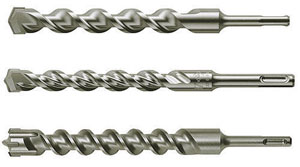 Boers
Boers
We decided to tell in this article about drills - a consumable tool for drilling mineral-based materials: concrete, brick, natural stone, etc. A feature of this type of drill is that their shank is not cylindrical, but with special grooves, the so-called SDS+. Under them, a special cartridge is needed that fixes the drills not due to sectors, but due to a special device into which the drill enters along the grooves.
The advantage of this design is that the drill can be replaced in a second with a different diameter without any problems.
It is these cartridges that are put on punchers sold in stores for both professional activities and domestic construction.
The drills have a tip made of hard material, which is fixed at the end of the drill and has sharp cutting edges. As the material for the tip, usually win or other hard material is used.
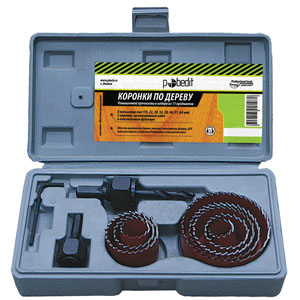 Crowns
Crowns
If we compare crowns with classic drills, then of course there is nothing in common with them, except that both of them are used for drilling holes. At the same time, crowns are needed for drilling large diameter holes in a wide variety of materials.
Structurally, the crowns are a metal structure in the form of a cylinder on the front face of which there are cutting teeth or pieces of abrasive are installed, and on the other hand there is a shank for which it can be fixed in the chuck of a perforator or electric drill.
Crowns can be divided into those that are used for drilling holes in wood or materials of similar density of small thickness. They can be distinguished by a removable shank, which is attached to the crown itself with a special nut, and for centering a conventional twist drill for wood or metal is installed in the shank. Crowns are made of steel by stamping and teeth are cut and sharpened on the edge.
Another class of drill bits is used for drilling materials such as concrete, brick or natural stone, as well as ceramic tiles, etc. These drill bits, which can reach a considerable length and diameter, have teeth made either in the form of teeth - sectors of pobedit or similar in hardness material, or in the form of deposited particles of very hard materials.
For crowns on durable reinforced concrete, abrasive particles are also introduced into the composition of the material of the crowns themselves and cutting elements are cut at the edge - this applies specifically to high-quality crowns. But with sectors from Pobedit, they usually sell cheap crowns for a small amount of work, for example, in domestic construction.
Cone drills
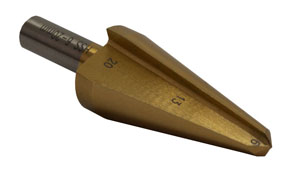 These drills, unlike all listed drills, are universal in terms of the diameter of the prepared holes. The fact is that cone drills, due to their design, allow you to drill holes of various diameters with one drill, the whole point is how deep you deepen it. The downside is that, in fact, you set the diameter with a mark on the material and control it “by eye”. Accordingly, you will not be able to achieve the accuracy of the hole millimeter to millimeter.
These drills, unlike all listed drills, are universal in terms of the diameter of the prepared holes. The fact is that cone drills, due to their design, allow you to drill holes of various diameters with one drill, the whole point is how deep you deepen it. The downside is that, in fact, you set the diameter with a mark on the material and control it “by eye”. Accordingly, you will not be able to achieve the accuracy of the hole millimeter to millimeter.
For precision work, it is better not to use such drills, but for construction or carpentry, for example, they are quite suitable. Please note that the wall of the hole will not be at 90 degrees but is made under a cone, which is not always suitable. 
Separately, in this section, we also note step drills, which are essentially one of the varieties of cone drills. And the peculiarity is that they have ledges of specific diameters and with their help you can easily make holes with high accuracy of various diameters. True, this drill is suitable only for thin sheet materials, the thickness of which does not exceed the height of the ledges on the drill.